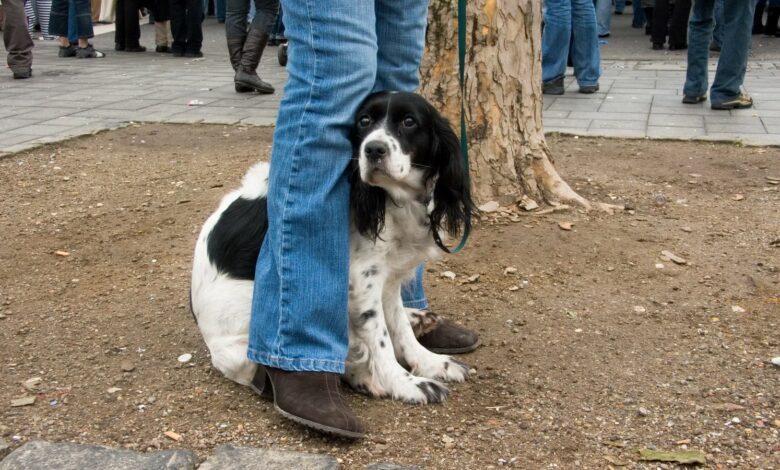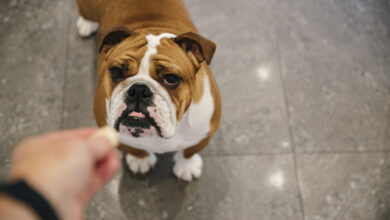How to Build Confidence in a Fearful Dog
Tips for helping your insecure, fearful, or so-called “submissive” dog gain confidence to improve the quality of her life.

The most critical thing you can do for your fearful dog is to have respect for that fear. When our dogs are scared of something that seems absurd to us – a guy in a hat, the vacuum, a flag blowing in the wind – we humans tend to respond by either laughing it off or getting frustrated, saying, “Oh, come on, that’s not going to hurt you.” We carry on normally (brushing right by the man in the hat) thinking one of these days the “silly” dog will figure out nothing bad is going to happen.
The thing is, from your dog’s perspective, the bad thing did happen. She was terrified, and her “trusted” human put her through that heart-pounding feeling again. So now she’s scared of The Thing and she learned she can’t rely on you.
That’s not the road to confidence-building. In fact, it’s the opposite. Here are five tips for growing and nurturing your fearful dog’s ability to move through the world feeling happy and secure.
Step 1: Eliminate the Scary Triggers
Nobody can learn when they’re scared, and dogs are no different. That’s why we have to start this process where – from your dog’s point of view – there is nothing to be afraid of. That means making sure there are no events that leave your dog trembling, hiding, pulling away, barking, growling, or drooling in fear.
The more precise you can be in identifying what scares your dog, the better. For example, is she worried about:
- All men, or just the ones in hats?
- All other dogs, or only the ones who bark?
- Guests at all times, or only when they stand up and walk around?
Once you have those answers, you have a job: In this initial phase, keep encounters with those things from happening. That might be easy; maybe you just have to tell your guests to take off their hats before coming inside. Or it might be incredibly difficult; maybe you have to quit your regular city walks entirely for now to avoid other dogs, and rely on indoor mental stimulation instead.
Either way, take heart: This stage doesn’t last forever. You will eventually move into re-introducing these triggers at an intensity your dog can handle, ideally turning them into a “Ho-hum, nothing to see here” part of life.
Step 2: Make Everyday Life Predictable
Many dogs who have a few big obvious triggers also have a general level of skittishness even when nothing much (from the human’s point of view) is happening. Some dogs live in a perpetual state of vague concern, which makes them more likely to fly off the handle when they do encounter one of their triggers. You can reduce this chronic concern by building more overall predictability into your dog’s life. Anxiousness is rooted in not knowing what’s going to happen next. To keep the overall, 24/7 arousal level as low as possible, create as much routine as you can. Do the same things, the same way, at the same time, every day.

Note that talking to your dog in a purposeful way can play a dramatic role in building predictability and increasing confidence. Narrate life so your dog can more quickly put various things in a “not to worry about” category. “Oh, yes, I do see that neighbor! It’s okay, that’s just our neighbor.” A piece of cheese after that conversation never hurts. (See “How to Talk to Your Dog,” June 2022.)
Step 3: Build Your Dog’s Trust in You
When we get to the stage of re-introducing triggers, you’re going to be your dog’s guide, helping him feel it’s okay to explore just a bit more closely. For this, your dog needs to trust you, absolutely. Before you think “Oh, he loves me, we’re already there,” just take this little quiz:
- Do you ever “make” your dog do stuff because you’re in a hurry? (Like drag him away by his leash from something he won’t leave alone, or just pick him up and carry him when he’s hesitant to come with you?)
- Do you ever yell at (or even around) your dog when you’ve had a bad day?
- Do you ever keep hugging your dog when he’s turning his head and pulling away?
These kinds of things may seem small to you, but day after day, interaction after interaction, they block the establishment of full trust. If you want to help your dog gain confidence, he must feel utterly secure with you. To get there, slow down. Respect your dog’s body language, and give him more say in his own life.
Step 4: Do Simple Training at Home
It may seem contradictory that I’m telling you to give your dog more agency and telling you to do more training. But that’s because the good kind of training isn’t about top-down commands and blind obedience (talk about a confidence-buster!). Instead, it’s about teaching your dog that good things are in her grasp, and the key is choosing to follow your direction: “Phew! I know exactly what’s going to happen in this situation! When my person says touch, all I have to do is put my nose to her hand and I get a treat.”
Sprinkling a few easy, short training sessions through your day at home is a key step as we move toward getting over individual fears. Is that because I’m going to tell you to command your dog to hold a down-stay as the children she’s terrified of run by? Oh my goodness no. (Goodbye progress, goodbye trust!)
Instead, use some simple “asks” as a barometer of how your dog is feeling. Let’s say you’ve made some progress having her around strange dogs in the park, and at a 30-foot distance she’s looking “fine.” To check, you ask for a simple touch, and she offers it – but if she grabs that treat roughly and turns immediately back to staring at the other dog, it means that she’s not quite as “fine” as she may have appeared you.
Or maybe when you cue a sit she offers a tiny little butt touch and an immediate return to a stand, rather than her usual relaxed sit as she waits for her treat. That’s great information! You may want to back up, let her observe for a while, and then try again. This time, does she decide that she feels secure enough, and she’d actually love to do a little training for treats? That’s important information about exactly where her threshold is.
Step 5: Set Up Careful Exposures
At this stage, whether it’s a few days, weeks, or months into your quest to build confidence, your dog should be feeling better in general. Her daily life is more predictable, she hasn’t had a heart-pounding experience in a while, and her people feel like folks she can hang her hat on.
Now it’s time to take this stronger foundation into the next phase, which is when we slowly reintroduce her triggers at a level she can handle. We want to give her the chance to learn about things she finds worrisome, but give her the control over the intensity dial. That allows her to build her database of information, so that she can come to more accurate conclusions about what should feel scary and what she can dismiss as inconsequential. That means you need to think carefully through setting up situations where you have control over all of the important variables and the levels of exposure. For example:
- If your dog is nervous around other dogs, select a big park where other dogs are far away and on lead – not a narrow path where you’ll be forced into a close encounter. (To help your dog feel more comfortable around other dogs, see “How to Socialize a Dog-Reactive Dog,” March 2023.)
- If your dog is scared of humans, get help from friends who will follow your instructions to stay seated, avoid eye contact, and resist the urge to reach out – and don’t go near strangers who insist on petting!
Have Faith!
Helping fearful dogs is one of those things in life where you simply must go slow to go fast. The initial phase – where you eliminate scary moments while also building your dog’s trust in you – can feel like you’re making no progress. But don’t give up, because that’s where the magic lies.
Your vet may be able to suggest anti-anxiety drugs that could speed your dog’s progress, but please don’t rely on drugs without also supporting your dog with the other things outlined here.
The exact process of successful “desensitization” will vary enormously from dog to dog and fear to fear. But if you lean into the first four steps, and then approach Step 5 with care, you are well on your way to a happier, waggier dog who’s able to experience a bigger life.




